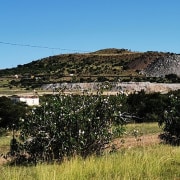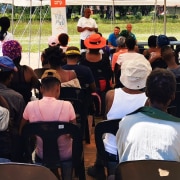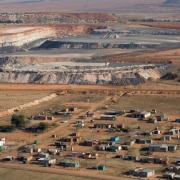|
Getting your Trinity Audio player ready...
|
By Erica Emdon and Jacob van Garderen
First published on Maverick Citizen
In 2018, Corruption Watch published its Mining Royalties research report, which looked at equity benefits and compensation flowing from mining, and whether these were reaching mining-affected communities. It concluded that widespread corruption was evident and that, overall, the communities most affected by mining were not benefiting, but continued to live in conditions of poverty. The report also highlighted the fact that few mining communities benefit from social and labour plans, which are detailed plans and commitments by mining companies to facilitate economic upliftment of mining communities.
Building on its findings, Corruption Watch shifted its focus to the different financial instruments that have been created to ensure proper compensation to communities, and why none appeared to be offering the protection they ought to be giving.
Defining a community
It is critical to identify the communities that are most affected by mining operations and that deserve to be the recipients of benefits. Doing so is complex and contentious, as there are layers of people affected.
The Mineral and Petroleum Resources Development Act (MPRDA) defines a community as a group of historically disadvantaged people with interests or rights in a particular area of land where they are living communally.
It adds that negotiations or consultations that take place with the community should include those who are directly affected by the mining operations. The mining-affected community becomes a key actor with which a mining company must negotiate, either as an entire community living in a communal area, or that part of that community directly affected by the mining.
The fact that this alternative exists is problematic, since it allows mining companies to choose the easier option, which they frequently do, and negotiate exclusively with traditional authorities rather than the households that live closest to the mining operations.
Two recent Constitutional Court judgments start homing in on whom the mining company should consult with. In Maledu and others v Itereleng Bakgatla Mineral Resources (Pty) Limited and others, Constitutional Court, Case No. 265/17, the applicants, who were 13 families or clans that claimed ownership of the land to be mined and would be most directly affected, were recognised by the court as the people with whom the mining company was ordered to negotiate. Baleni and others v Minister of Mineral Resources and Others, North Gauteng High Court, Case No. 73768/2016 is another example of a rural community, in this case a group of small villages in Xolobeni in the Eastern Cape, which is at risk of being displaced by a mining company from their land that they have occupied since the early 1800s.
Various people from mining-affected communities, academics and NGOs interviewed believe that the community is frequently a very clearly identifiable set of households that either own the land and/or will be directly affected by mining – their homes may need to be demolished, they might need to be relocated, their ancestral graves might have to be moved, and their farmlands replaced. Communities are not one huge conglomerate, but consist of households and the individuals within these households.
Once it is clear who the mine-affected community is, the right to say no, or to give free and informed consent, must be recognised. Prior to the passing of the MPRDA in 2002, the Minerals Act vested mining rights in the owner of land who was, in terms of the law, empowered to decide if they wanted mining to take place on their land or not, and could categorically say no.
The MPRDA changed this by placing ownership of minerals in state hands, and providing that the community for whose land the mining licence is sought must be consulted by a prospective mineral rights holder prior to a licence being issued. If the community happens to be on land that is covered by the Interim Protection of Informal Land Rights Act (Ipilra), then the mineral rights holder cannot deprive people of their land without their consent. Land covered by Ipilra is communally owned land, land that was located in the Bantustans under apartheid, or land held in trust by the South African Development Trust, or by a traditional authority.
There are, therefore, currently two parallel approaches. In terms of the MPRDA, mining companies must consult with communities when they intend to mine, but if the communities live on land covered by Ipilra they must get consent. Theoretically, this means communities on land covered by Ipilra are in a stronger position than those located on other land.
The implications of being able to say no is critical for communities that are affected by mining. It enables an affected community to genuinely and with the backing of law negotiate terms of compensation that benefit them. Consultation does not have this weight, and parties to consultations are not in a position to make ultimatums and demands. In the Baleni judgment, the court held that once consent is required for mining operations in terms of the law, in this case in terms of Ipilra, it includes the right to say no.
Once a community has been able to assert its right to negotiate meaningfully, the type of compensation and benefit comes under discussion, as well as the manner in which it will reach the affected households and broader community that might be affected.
In general, the community trust has been the most popular and widely used legal structure to manage the receipt of compensation and equity. A community trust is a legal body that is set up in terms of the Trust Property Control Act, through which ownership in property of one person is, by virtue of a trust deed, made over to a trustee to administer for the benefit of others. In other words, the mines give over the compensation and/or equity they wish the community to receive to the trust, and delegate to trustees the task of administering and disposing of such assets.
What compensation?
Trusts have been abused and misused, and frequently taken over by trustees who have not looked after the interests of the community most affected by mining. Various commissions of enquiry, the Public Protector, the South African Human Rights Commission, and many court cases confirm this, with hundreds of millions of rands disappearing over the years into the hands of consultants, traditional authorities, politicians and others, rather than going to the people most affected by mining.
Most frequently, trusts are set up by mining companies, and in many instances their lawyers, who draft the trusts, determine how many trustees there should be and from where. There are various permutations, generally including some independent trustees, others that are from the mining company, and a certain number from the community and/or the traditional authority.
In North West, for instance, the Bakgatla ba Kgafela traditional authority was placed under administration following damning findings by the Baloyi Commission of Inquiry that Bakgatla Chief Pilane was responsible for the mismanagement of the community’s substantial wealth. The Moruleng community, who own the platinum-rich land has, sadly, had no input or oversight over the deals and investments that were made on their behalf.
The mismanagement of community trusts is not unique to the mining sector, and similar examples of maladministration can be found in sectors such as land reform and agriculture. In Mpumalanga, the courts intervened to remove trustees in the Mjejane and Ingwenyama Simhulu trusts, following years of mismanagement of trust money by unscrupulous trustees, who failed to pay beneficiaries their deserved compensation. These two trusts were created pursuant to the restitution of the lucrative Tensbosch sugarcane farms.
However, it is not just community trusts that are vulnerable to poor and unscrupulous governance. There are also examples of community-owned companies being raided of funds and investments meant for the beneficiary community. A good example is the Bapo Ba Mogale Investments (BBMI) company, which was created to be the business arm of the Bapo Ba Mogale mining community. Without the required consent of the community, the company directors swapped the annual royalties from the platinum mines for cash and equity in Lonmin PLC and transferred the funds to the “D Account”, managed by the North West provincial government, from where it quickly disappeared. The Bapo Ba Mogale community was thus defrauded of more than R600-million.
Some ask whether it would be better for mining benefits to be paid through non-profit companies or communal property associations. While there may be some consensus that any of the legal forms currently available in our law can be used as vehicles for compensation, the upshot is that a vital ingredient for sustainability of the sector is the manner in which the community is brought into the process.
As one informant said, “It’s not necessarily trust that is the problem. The problem is the governance issues and accountability. Independent trustees are important. They can take a little bit of a bird’s eye view and aren’t themselves benefiting.”
Key elements of effective community trusts
There are, of course, exceptions and good practice cases. But unfortunately these are far fewer than the examples where the entire mining situation is deeply detrimental to the community. There are key elements required of any legal vehicle used in the context of mining benefits, most of which relate to good governance.
This starts with clear, sufficiently objective and measurable criteria as to who the beneficiaries are. It must be possible to apply a test to determine who is a beneficiary and who is not, who qualifies and who does not.
Secondly, trustees should have to disperse a minimum value every year. What has been problematic is trustees sitting year after year earning fees, and not dispersing benefits. There should be some definition of a minimum contribution that beneficiaries must receive every year. Further, a trust must be very specific about what types of projects will qualify for benefit.
A point made by an informant that specialises in community trusts is that in the mining context, there must be a diversity of income streams. The trust must not be restricted to only mining equity or income from the mine. When mining goes through boom times, there are dividends and income. But there are times where there is not much income. In order to meet community expectations, other investments must be made.
There are other prerequisites for a properly functioning community trust. There must be significant and meaningful representation from the community. Community members must be able to access the relevant information about the trust, including trust documents, agreements and financial reports. They should be given proper notice of meetings, while venues should be big enough to house all the beneficiaries and transport to venues should be provided. Meeting times should accommodate beneficiaries, and there should be translators if necessary.
In other words, every effort should be made by all parties – the trustees, mines that are compensating communities, and communities themselves – to create a manner of operation that is inclusive, transparent and is based on a commitment to ensuring that mining benefits flow to where they are supposed to flow.
Oversight needed for vulnerable community trusts
In the end, the situation might need an outside oversight body like an ombud to provide parties some protection. Community trusts are vulnerable. They are imperfectly designed, and they are vulnerable because often they are set up in poor communities whose members are not afforded a legitimate seat at the table. They then outsource the role to elites, and trusts are thus captured by people who are unscrupulous and self-interested.
In many cases, it might not be the mine itself that is the problem, but it might be fraudulent traditional councils, provincial governments, individuals who see an opportunity, lawyers, financial advisers or any manner of person that sees an opening for self-enrichment.
Neither the Department of Mineral Resources nor the Master’s Office, both of which are meant to play some form of oversight role, are doing so. The Master’s Office is responsible for registering trusts and does have a regulatory responsibility to ensure that they are administered properly. If there is evidence of irregularity the Master can inspect the trust’s books, and request trustees to remedy any irregularity found. If the trustee fails to do so, the Master or any other person with an interest in the trust may apply to court for an order to compel the trustee to take remedial action. In practice the Master’s offices are not playing a regulatory role, as they are understaffed and rarely in a position to take trustees to court.
In the absence of oversight by these bodies, it is time to seriously consider other options to ensure that the flow of dividends and compensation to mining affected communities reaches the correct destination. One way to ensure a measure of protection is in the drafting of the trust instrument, which can provide, if properly drafted, a number of protections for communities. In this case the role of the Master’s Office is not as important, since the terms of the trust, and the ability of the mining affected community to ensure they are implemented, might offer sufficient protection. If you add to that an ombud, to whom people can complain if the terms of trusts are violated or not implemented, you might achieve more meaningful oversight.
The Broad-Based Black Economic Empowerment Act published a code of good practice that set out some rules for BEE trusts to ensure they are not abused. For example, at least 50% of trustees must be independent people with no direct beneficial interest in the scheme, and at least 50% must be black, of which 25% should be women. Beneficiaries must be defined, and there must be a fixed percentage of entitlement or use of a formula to define proportion.
Various other requirements are set out, and while these may not all be appropriate, and while there may be a need for others, this type of guidance on how a trust deed should be constructed could be a very useful mechanism to protect the beneficiaries.
Erica Emdon and Jacob van Garderen are the directors of Public Interest Practice and write on behalf of Corruption Watch.








